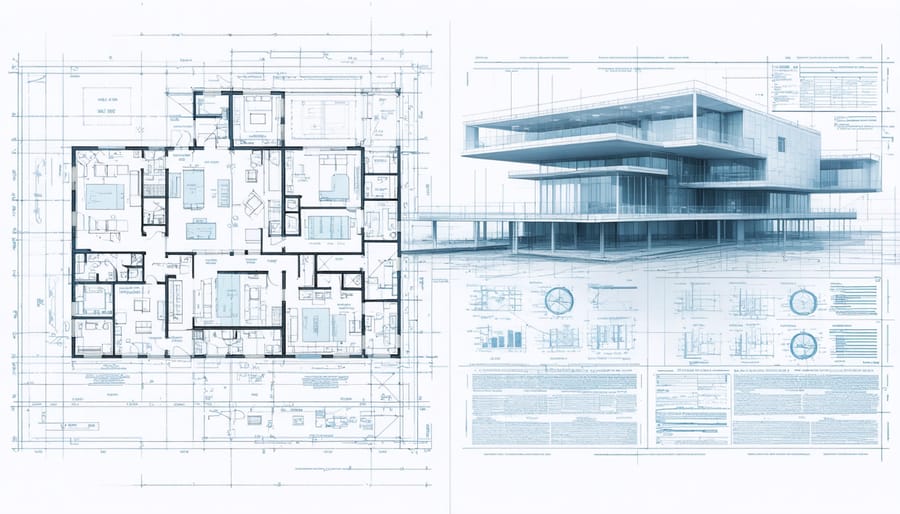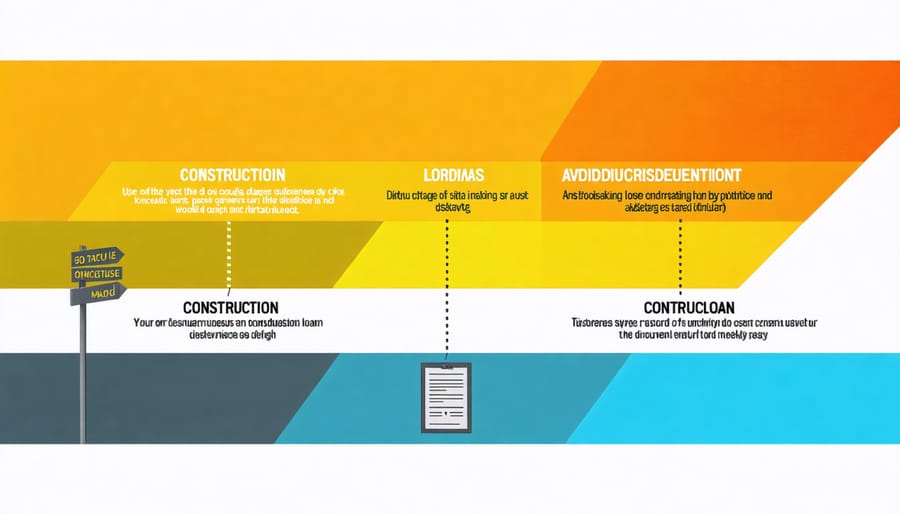In today’s dynamic construction landscape, securing the right financing can make or break a development project’s success. Interim financing and construction loans serve as critical funding bridges, enabling developers to transform architectural blueprints into tangible assets. These specialized financial instruments address the unique cash flow challenges inherent in construction projects, where capital requirements evolve dramatically from groundbreaking to completion.
Understanding the interplay between interim financing and construction loans isn’t just about accessing capital—it’s about strategically leveraging these tools to optimize project timelines, manage costs, and maintain operational flexibility. Construction professionals and developers who master these financing mechanisms gain a significant competitive advantage, particularly in markets where timing and financial efficiency determine project viability.
As construction costs continue to rise and market conditions remain volatile, the importance of structuring these financial solutions effectively has never been more crucial. This comprehensive guide examines the fundamental aspects of interim financing and construction loans, offering practical insights for industry professionals seeking to navigate the complex landscape of construction finance while maximizing project returns and minimizing risk exposure.
Understanding Interim Financing vs. Construction Loans
The Role of Interim Financing
Interim financing serves as a crucial bridge between initial project funding and permanent financing in construction projects. This short-term funding solution typically covers the active construction phase, allowing developers and contractors to manage cash flow effectively while work progresses. The financing structure usually involves progressive disbursements, also known as draws, which are released as construction milestones are achieved.
Common applications include ground-up construction projects, major renovations, and property redevelopment initiatives. The loan amount generally ranges from 70% to 80% of the project’s construction costs, with terms typically spanning 12 to 36 months. Interest rates are usually variable and based on prime rate plus a margin, reflecting the higher risk nature of construction lending.
Key mechanics involve detailed draw schedules, regular construction progress inspections, and careful monitoring of project timelines and budgets. Lenders typically require comprehensive documentation, including approved building permits, detailed cost breakdowns, and construction schedules. This financing method proves particularly valuable for developers managing multiple projects simultaneously or when permanent financing arrangements require completed construction for approval.
Construction Loan Fundamentals
Construction loans serve as specialized financing instruments designed specifically for new building projects and major renovations. Understanding these construction loan fundamentals is crucial for project success. These loans typically feature a short-term structure, usually 12-24 months, with draws disbursed according to predetermined construction milestones.
Lenders generally require a comprehensive project plan, including detailed cost estimates, construction timeline, and contractor credentials. Most construction loans mandate a down payment of 20-30% of the total project cost, though requirements vary based on project scope and borrower qualifications. Interest rates tend to be higher than conventional mortgages, reflecting the increased risk associated with construction projects.
Key requirements include proof of contractor insurance, detailed blueprints, permits, and a clear path to permanent financing. Lenders typically conduct regular inspections before releasing additional funds, ensuring work quality meets established standards. Understanding these requirements and structuring your application accordingly significantly increases approval chances and enables smooth project execution.
Key Requirements for Approval

Financial Documentation
To secure interim financing or a construction loan, lenders typically require a comprehensive package of financial documentation. This includes detailed financial statements such as balance sheets, income statements, and cash flow statements for the past three years. Current financial ratios and working capital position must be clearly demonstrated through these documents.
Project-specific documentation requirements encompass detailed construction cost breakdowns, including hard costs (materials, labor) and soft costs (permits, architectural fees). A well-structured project pro forma showing expected returns, projected rental income or sales revenue, and detailed operating expense projections is essential.
Borrowers must provide personal financial statements, including tax returns for the past two years, schedule of real estate owned, and documentation of other business interests. For corporate borrowers, entity formation documents, operating agreements, and corporate tax returns are necessary.
The construction budget should include a detailed timeline of draw requests aligned with construction milestones. Lenders also require feasibility studies, market analysis reports, and comparable property assessments to validate project viability.
Additional documentation includes contractor credentials, construction contracts, architectural plans, permits, and zoning approvals. Environmental reports, soil tests, and property appraisals complete the package. Having these documents properly prepared and organized significantly streamlines the loan approval process and demonstrates project readiness to potential lenders.
Project Documentation
Comprehensive project documentation is crucial for securing interim financing and construction loans. Lenders typically require a complete set of construction plans stamped by licensed architects and engineers, demonstrating compliance with local building codes and zoning regulations. These plans must include detailed architectural drawings, structural calculations, and mechanical, electrical, and plumbing (MEP) specifications.
Building permits and regulatory approvals are essential components of the documentation package. This includes zoning permits, environmental impact assessments, and any special use permits required by local authorities. Lenders will verify that all necessary permissions are in place before releasing funds.
Contractor agreements must be thoroughly documented through executed contracts that outline scope of work, payment schedules, completion timelines, and performance guarantees. These agreements should include detailed cost breakdowns, material specifications, and quality control measures. General contractors must provide proof of licensing, insurance certificates, and performance bonds.
Supporting documentation typically includes a construction schedule with clear milestones, a detailed budget breakdown, and contingency plans for potential delays or cost overruns. Subcontractor agreements, material supplier contracts, and labor agreements should also be included to demonstrate project feasibility.
Project documentation should be organized systematically, with clear indexing and version control. Regular updates may be required throughout the construction phase, particularly when seeking additional draws from the construction loan.
Risk Assessment and Mitigation
Lender Risk Considerations
Lenders carefully evaluate multiple risk factors before approving interim financing or construction loans. The primary considerations include the developer’s track record, financial stability, and experience in similar projects. Project feasibility analysis plays a crucial role, with lenders examining market conditions, location demographics, and potential return on investment.
Construction-specific risks are thoroughly assessed, including contractor qualifications, building permits, zoning compliance, and environmental factors. Lenders typically require detailed construction schedules, cost breakdowns, and contingency plans to mitigate potential delays or budget overruns.
The loan-to-value (LTV) ratio is a critical metric, with most lenders limiting exposure to 65-75% of the project’s completed value. Pre-leasing or pre-sales requirements may be imposed to ensure project viability and reduce market risk.
Collateral requirements often extend beyond the project itself, potentially including personal guarantees or additional assets. Exit strategy analysis is essential, with lenders evaluating take-out financing options or sales projections.
Lenders also consider macroeconomic factors such as interest rate trends, real estate market conditions, and sector-specific risks. Regular project monitoring, including construction progress inspections and cost verification, helps maintain risk control throughout the loan term.

Risk Mitigation Strategies
To enhance the likelihood of loan approval and minimize potential risks, implementing effective risk mitigation strategies is crucial. Start by maintaining detailed financial documentation, including comprehensive project budgets, cash flow projections, and contingency plans. Secure pre-construction contracts and permits before applying for financing to demonstrate project viability.
Consider obtaining performance bonds and construction insurance to protect against contractor default and unforeseen circumstances. Implement robust cost control measures and maintain a contingency fund of 10-15% of the total project cost to address unexpected expenses or delays.
Strengthen your application by presenting a clear exit strategy, whether through permanent financing arrangements or property sale. Consider working with experienced construction managers and established contractors with proven track records to enhance lender confidence.
Regular project monitoring and reporting systems should be established to track construction progress and financial expenditure. This transparency helps maintain lender confidence and enables early identification of potential issues. Additionally, maintaining strong relationships with multiple lenders can provide financing alternatives if needed and potentially better terms through competition.
Finally, engage qualified legal counsel to review all contracts and ensure compliance with lending requirements throughout the construction phase.

Cost Structures and Interest Rates
Construction loan and interim financing costs typically comprise several key components that borrowers must carefully consider. Interest rates for these loans generally range from prime rate plus 2-4%, though rates can vary significantly based on project specifics and market conditions. Unlike traditional mortgages, these loans utilize a progressive draw schedule, where interest is only charged on disbursed funds.
The cost structure includes origination fees (typically 0.5% to 1.5% of the total loan amount), commitment fees (0.5% to 1%), and various due diligence costs such as appraisal fees, environmental assessments, and legal documentation expenses. Lenders may also require a contingency reserve of 5-10% of the project cost to cover unexpected expenses.
Interest rates are typically variable and tied to benchmark rates such as LIBOR or prime rate. The specific rate spread depends on several factors:
– Borrower’s creditworthiness and financial strength
– Project feasibility and market conditions
– Loan-to-value ratio (typically 65-80%)
– Developer’s track record and experience
– Pre-leasing or pre-sales commitments
– Quality of construction documentation and permits
Most construction lenders require monthly interest payments during the construction period, with principal due upon project completion or refinancing. Some loans may include interest reserves built into the loan amount to cover payments during construction.
For larger projects, syndicated loans might be necessary, potentially involving multiple lenders and resulting in more complex fee structures. The total cost of financing typically represents 3-7% of the total project cost, making it crucial for developers to negotiate favorable terms and maintain adequate contingency reserves.
To optimize financing costs, borrowers should consider timing their applications with favorable market conditions, maintaining strong relationships with multiple lenders, and ensuring comprehensive project documentation to secure better rates and terms.
Alternative Financing Options
Beyond traditional interim and construction loans, developers and construction firms can explore several alternative financing options to fund their projects. Private equity partnerships have gained traction in recent years, offering significant capital without the stringent requirements of traditional lenders. These partnerships typically involve sharing project ownership but provide greater flexibility in terms of repayment structures.
Mezzanine financing represents another viable option, bridging the gap between senior debt and equity. This hybrid approach combines elements of debt and equity financing, often proving beneficial for larger-scale developments where traditional lending falls short of the required capital stack.
Crowdfunding platforms specifically designed for real estate and construction projects have emerged as innovative funding sources. These platforms allow developers to access capital from multiple investors while maintaining project control, though they typically require comprehensive project documentation and marketing efforts.
Equipment financing and sale-leaseback arrangements can help free up capital by leveraging existing assets. These structures enable construction firms to maintain operational capacity while redirecting funds toward project completion.
Joint ventures with established developers or investment firms present opportunities for risk-sharing and enhanced project viability. These partnerships often bring additional expertise and market credibility alongside financial resources.
Bond financing, particularly for larger commercial projects, offers competitive interest rates and longer repayment terms. Municipal bonds may be available for projects with public benefit components, providing tax advantages and potentially lower borrowing costs.
Each alternative carries distinct advantages and considerations regarding control, cost, and complexity. Successful implementation often requires careful evaluation of project specifics and market conditions to determine the most suitable financing structure.
Understanding and navigating interim financing and construction loans is crucial for successful project execution in today’s construction landscape. Throughout this guide, we’ve explored the fundamental aspects of these financing options, from their distinct characteristics to application requirements and risk management strategies.
Remember that successful financing begins with thorough preparation. Start by assembling comprehensive project documentation, including detailed cost estimates, construction schedules, and market analysis. Maintain strong relationships with potential lenders and consider working with experienced financial advisors who understand the construction industry’s unique challenges.
To move forward with your financing journey, take these essential steps:
1. Evaluate your project’s specific needs and timeline
2. Prepare a detailed business plan and financial projections
3. Gather all required documentation
4. Compare multiple lenders and their terms
5. Consider engaging a construction finance specialist
Stay mindful of market conditions and interest rate trends that may impact your financing costs. Regular communication with stakeholders and careful monitoring of construction progress will help ensure smooth disbursements and project completion.
By understanding these financing tools and implementing proper risk management strategies, you’ll be better positioned to secure the funding needed for your construction project while maintaining financial stability throughout the building process.
Consider consulting with financial and legal professionals to determine the most appropriate financing structure for your specific situation and project requirements.

